|
|
 |
|
Calanoida ( Order ) |
|
|
|
Calanoidea ( Superfamily ) |
|
|
|
Calanidae ( Family ) |
|
|
|
Calanus ( Genus ) |
|
|
| |
Calanus jashnovi Hulsemann, 1994 (F,M) | |
| | | | | | | Syn.: | Calanus finmarchicus : ? Mori, 1937 (1964) (p.13); Tanaka, 1956 (p.252, large forms: figs. 1c,d,f,i);
Calanus glacialis : Park, 1968 (p.530, figs.1,2);
Calanus orientalis Jaschnov, 1975 (p.35, figs.F,M);
Calanus sinicus (large forms): Kidachi, 1979; Kidachi & Yamamoto, 1980; Toda & Hirose, 1991 | | | | Ref.: | | | Hulsemann, 1994 (p.1467, figs.F,M); Chihara & Murano, 1997 (p.738, Pl.67: F,M); Hsiao & al., 2004 (p.324, figs.F, Juv.5, Rem.); |  issued from : K. Hulsemann in Invert. Taxon., 1994, 8. [p.1463, Fig.2]. Female (from NW Pacific): 2, habitus (dorsal). Scale bar = 0.5 mm.
|
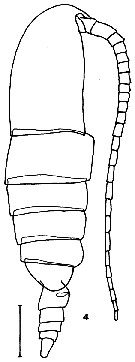 issued from : K. Hulsemann in Invert. Taxon., 1994, 8. [p.1464, Fig.4]. Female (from NW Pacific): 2, habitus (lateral). Scale bar = 0.5 mm.
|
 issued from : K. Hulsemann in Invert. Taxon., 1994, 8. [p.1466, Fig.10]. Female (from NW Pacific): 10, forehead (lateral). Scale bar = 0.5 mm.
|
 issued from : K. Hulsemann in Invert. Taxon., 1994, 8. [p.1467, Figs.12, 14]. Female (from NW Pacific): 12, geital segment (ventral); 14, idem (lateral).
|
 issued from : K. Hulsemann inInvert. Taxon., 1994, 8. [p.1476, Figs.25-27]. Female: (from NW Pacific); schematic, showing sites of integumental organs: 25, urosome (dorsal); 26, idem (lateral); 27, idem (ventral). Filled circle: 100 % presence; open circle: 95-99 % presence; triangle: 40-49 % presence; dot: 30 % or less presence. n = 49.
|
 issued from : K. Hulsemann in Invert. Taxon., 1994, 8. [p.1465, Fig.6]. Male (from NW Pacific): 6, habitus (dorsal). Scale bar = 0.5 mm.
|
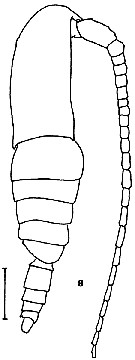 issued from : K. Hulsemann in Invert. Taxon., 1994, 8. [p.1466, Fig.8]. Male (from NW Pacific): 8, habitus (lateral). Scale bar = 0.5 mm.
|
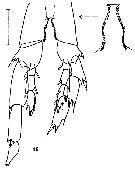 issued from : K. Hulsemann in Invert. Taxon., 1994, 8. [p.1469, Fig.16] Male (from NW Pacific): 16, P5 (posterior). Scale bar = 0.2 mm.
|
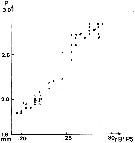 issued from : K. Hulsemann in Invert. Taxon., 1994, 8. [p.1471, Fig.17] Male (from NW Pacific): 17, length of 1st basal segment of right P5 male (rB1P5) plotted against prosome (P) length of males of Calanus sinicus (open circles) and C. jashnovi (filled circles). n = 23.
|
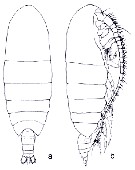 issued from S.-H. Hsiao, C.-Y. Lee, C.-t. Shih & J.-S. Hwang in Zool. Studies, 2004, 43 (2). [p.327, Fig.2]. Female (from E Taiwan): a-b, habitus (dorsal and lateral, respectively). Body length = 3.96 mm. Nota: Cephalosome and pedigerous somite 1 separate, 4 and 5 separate. Rostrum with 2 long thin filaments. Posterior corners of prosome triangular dorsally and laterally, with tip bent slightly outward from dorsal view. Urosome 4-segmented. Genital double-somite symmetrical and slightly convex on both lateral margins, widest slightly anterior to middle of somite. Length of urosomites 2-4 decreasing posteriorly. Caudal rami subequal to combined length of urosomites 3 and 4. A1 25-segmented, reaching distal margin of urosomite 3
|
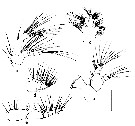 issued from S.-H. Hsiao, C.-Y. Lee, C.-t. Shih & J.-S. Hwang in Zool. Studies, 2004, 43 (2). [p.328, Fig.3, a-e]. Female: a, A2; b, Md; c, Mx1; d, Mx2; e, Mxp. Scale bar = 0.5 mm. Protopod of A2 2segmented; coxa with 1 inner seta, basis bearing 2 inner setae; exopod nearly as long as endopod, 10-segmented (segment 1 partly fused to 2 and 3 to 4), each of segments 1-8 with 1 inner seta, segment 9 elongate with 1 seta on mid-posterior surface, distal segment small, with 3 apical setae. Endopod 2-segmented, proximal segment elongate with 2 inner setae near distal end and some fine setae at outer distal corner; distal segment bilobed, armed with 9 and 7 apical setae on inner and terminal lobes, respectively. Md: Gnathobase bearing 1 dorsal seta and 7 blades, being single-cusped at both dorsal and ventral ends and multicusped in middle blades; a triangular process between the first 2 ventral blades. Basis with 4 setae. Exopod 5-segmented, each of the 4 proximal segments with 1 inner seta; distal segment with 2 apical setae. Endopod 2-segmented, proximal segment with a semicircular inner margin, bearing 4 inner setae at distal end, and some fine setae on inner and distal outer margins, distal segment with 11 apical setae and some fine setae on both inner and outer margins. Mx1: Medial arthrite (1st inner lobe) of praecoxa armed with 10 spines on outer margin, 4 setae on posterior surface, and 1 minute spine on posterior surface near distal margin; coxa bearing 1 endite (2nd inner lobe) armed with 4 apical setae and 1 epipodite (1st outer lobe) bearing 9 setae (the 2 proximal setae much finer); basis bearing 2 endites (3rd and 4th inner lobes) and 1 exite (2nd outer lobe), both endites armed with 4 apical setae, exite equipped with 1 small seta; exopod 1-segmented, bearing 11 setae on outer and distal margins; endopod 3-segmented with 4 outer setae on each of the 2 proximal segments and 7 apical setae on distal segment. Mx2: Praecoxa bearing 2 endites (1st and 2nd inner lobes) with 6 and 4 apical setae; coxa also bearing 2 endites (3rd and 4th inner lobes), each with 3 apical setae, and 1 outer seta; basis with 1 endite (5th inner lobe) armed with 4 setae; endopod 4-segmented, bearing 3, 2, 2, and 3 setae, respectively. Mxp: Syncoxa possessing 4 shallow endites with 1, 2, 4, and 4 setae, respectively; basis with 3 setae on inner margin; endopod 6-segmented, segments 1-5 from proximal to distal, each with 2, 4, 4, 3, and 3 setae, respectively, on inner margin, segment 6 with 3 apical setae, segments 5 and 6 each also bearing 1 outer seta.
|
 issued from S.-H. Hsiao, C.-Y. Lee, C.-t. Shih & J.-S. Hwang in Zool. Studies, 2004, 43 (2). [p.328, Fig.3, f-j]. Female: f-j, P1 to P5; k, enlargement of coxa of P5. Scale bars: S1 = 0.5 mm; S2 = 0.1 mm. Nota: Coxa of P5 bearing 20-26 small teeth on curved inner border; length/width proportion of the segment 1.38-1.45.
|
 issued from S.-H. Hsiao, C.-Y. Lee, C.-t. Shih & J.-S. Hwang in Zool. Studies, 2004, 43 (2). [p.327, Table 2]. Female: Spine and setal formula of swimming legs P1-P5. Arabic numerals = setae; Roman numerals = spines.
| | | | | Compl. Ref.: | | | Dur & al., 2007 (p.197, Table IV); Kobari & al., 2008 (p.1648, coppodids I-VI, depth distribution); Takahashi & al., 2008 (p.222, Table 2, grazing impact); Hsiao S.H. & al., 2011 (p.475, Appendix I); Takenaka & al., 2012 (p.1669, fig.2, Table 1, bioluminescence); Kobari & al., 2013 (p.78, Table 2); Chiba S. & al., 2015 (p.968, Table 1: length vs climate) | | | | NZ: | 4 | | |
|
Distribution map of Calanus jashnovi by geographical zones
|
| | | | | |  issued from : K. Hulsemann in Invert. Taxon., 1994, 8. [p.1474, Fig.18] issued from : K. Hulsemann in Invert. Taxon., 1994, 8. [p.1474, Fig.18]
Distribution of calanus sinicus (unshaded) and C. jashnovi (shaded) in the NW Pacific Ocean. Type localities of C. sinicus (1) and C. jashnovi (2). |
| | | | Loc: | | | N Pacific (temperate); China Seas (South China Sea), Taiwan (SW, E: Kuroshio Current), E Japan, S. Hokkaido); Oyashio region, SE Kamchatka | | | | N: | 16 | | | | Lg.: | | | (125) F: 4,07-3,5; M: 3,7-3; (126) F: 4,4-3,4; M: 3,8-3; (882) F: 3,72-4,20; {F: 3,40-4,40; M: 3,00-3,80}
The mean female size is 3.882 mm (n = 6; SD = 0.4023), and the mean male size is 3.375 mm (n = 4; SD = 0.4349). The size ratio (male : female) is 0.879 (n = 2).
Chiba S. & al., 2015 (p.971, Table 1: Total length female (June-July) = 3.9 mm [optimal SST (°C) = 14.2]. | | | | Rem.: | For Hulsemann (1994, p.1469) this species resembles C. sinicus (see remarks in this latter species).
After Hsiao & al. (2004, p.330) This species may be separated from C. sinicus by body size; length of A1 (shorter than body length vs. 2 segments exceeding body length); length/width proportion of the coxa of P5 (1.38-1.45 vs. 1.60-1.75). The species may be indicator of the North Pacific Intermediate waters (NPIW). The predominance of copepodite 5 in the Taiwan east region is probably an indication that C. jashnovi may be entering dormancy to avoid adverse conditions in ths region of the NPIW, far away from its origin. | | | Last update : 28/09/2016 | |
|
|
 Any use of this site for a publication will be mentioned with the following reference : Any use of this site for a publication will be mentioned with the following reference :
Razouls C., Desreumaux N., Kouwenberg J. and de Bovée F., 2005-2025. - Biodiversity of Marine Planktonic Copepods (morphology, geographical distribution and biological data). Sorbonne University, CNRS. Available at http://copepodes.obs-banyuls.fr/en [Accessed October 24, 2025] © copyright 2005-2025 Sorbonne University, CNRS
|
|
 |
 |















